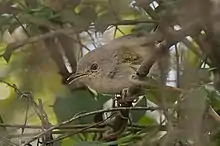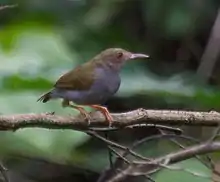Camaroptera
Camaroptera is a genus of small passerine birds in the family Cisticolidae that are found in sub-Saharan Africa.
| Camaroptera | |
|---|---|
.jpg.webp) | |
| Grey-backed camaroptera (Camaroptera brevicaudata) | |
| Scientific classification | |
| Domain: | Eukaryota |
| Kingdom: | Animalia |
| Phylum: | Chordata |
| Clade: | Dinosauria |
| Class: | Aves |
| Order: | Passeriformes |
| Family: | Cisticolidae |
| Genus: | Camaroptera Sundevall, 1850 |
| Type species | |
| Camaroptera olivacea[1] Sundevall, 1850 | |
The genus was erected by the Swedish zoologist Carl Jakob Sundevall in 1850. The type species is the green-backed camaroptera (Camaroptera brachyura).[2][3] The word Camaroptera comes from the Ancient Greek kamara for "arch" and pteron for "wing".[4]
Species
The genus contains the following five species:[5]
| Image | Common Name | Scientific Name | Distribution |
|---|---|---|---|
.jpg.webp) | Green-backed camaroptera | Camaroptera brachyura | Zambia, Kenya, Malawi, Mozambique, and Tanzania |
.jpg.webp) | Grey-backed camaroptera | Camaroptera brevicaudata | Africa south of the Sahara Desert. |
 | Hartert's camaroptera | Camaroptera harterti | Angola. |
.jpg.webp) | Yellow-browed camaroptera | Camaroptera superciliaris | Angola, Benin, Cameroon, Central African Republic, Republic of the Congo, Democratic Republic of the Congo, Ivory Coast, Equatorial Guinea, Gabon, Ghana, Guinea, Liberia, Nigeria, Sierra Leone, Togo, and Uganda. |
 | Olive-green camaroptera | Camaroptera chloronota | Benin, Cameroon, Central African Republic, Republic of the Congo, Democratic Republic of the Congo, Ivory Coast, Equatorial Guinea, Gabon, Gambia, Ghana, Guinea, Kenya, Liberia, Mali, Nigeria, Rwanda, Senegal, Sierra Leone, South Sudan, Tanzania, Togo, and Uganda. |
Molecular phylogenetic studies have shown that the green-backed and the grey-backed camaroptera are closely related,[6][7][8] and some taxonomists treat them as conspecific.[9]
References
- "Cisticolidae". aviansystematics.org. The Trust for Avian Systematics. Retrieved 2023-07-15.
- Sundevall, Carl Jakob (1850). "Camaroptera". Öfversigt Af Kongl. Vetenskaps-akademiens Forhandlingar (in Swedish). 7: 103.
- Mayr, Ernst; Cottrell, G. William, eds. (1986). Check-list of Birds of the World. Vol. 11. Cambridge, Massachusetts: Museum of Comparative Zoology. pp. 185–186.
- Jobling, James A. (2010). The Helm Dictionary of Scientific Bird Names. London: Christopher Helm. p. 86. ISBN 978-1-4081-2501-4.
- Gill, Frank; Donsker, David, eds. (2017). "Grassbirds, Donacobius, Malagasy warblers, cisticolas & allies". World Bird List Version 7.3. International Ornithologists' Union. Retrieved 26 August 2017.
- Nguembock, B.; Fjeldså, J.; Tillier, A.; Pasquet, E. (2007). "A phylogeny for the Cisticolidae (Aves: Passeriformes) based on nuclear and mitochondrial DNA sequence data, and a re-interpretation of an [sic] unique nest-building specialization". Molecular Phylogenetics and Evolution. 42 (1): 272–286. doi:10.1016/j.ympev.2006.07.008. PMID 16949311.
- Nguembock, B.; Cruaud, C.; Denys, C. (2012). "A large evaluation of passerine cisticolids (Aves: Passeriformes): more about their phylogeny and diversification". Open Ornithology Journal. 5: 42–56. doi:10.2174/1874453201205010042.
- Olsson, U.; Irestedt, M.; Sangster, G.; Ericson, P.G.P.; Alström, P. (2013). "Systematic revision of the avian family Cisticolidae based on a multi-locus phylogeny of all genera". Molecular Phylogenetics and Evolution. 66 (3): 790–9. doi:10.1016/j.ympev.2012.11.004. PMID 23159891.
- Ryan, P. (2017). del Hoyo, J.; Elliott, A.; Sargatal, J.; Christie, D.A.; de Juana, E. (eds.). "Bleating Camaroptera (Camaroptera brachyura)". Handbook of the Birds of the World Alive. Lynx Edicions. doi:10.2173/bow.grbcam1.01. S2CID 216434155. Retrieved 27 August 2017.
- Ryan, Peter (2006). Family Cisticolidae (Cisticolas and allies). pp. 378–492 in del Hoyo J., Elliott A. & Christie D.A. (2006) Handbook of the Birds of the World. Volume 11. Old World Flycatchers to Old World Warblers Lynx Edicions, Barcelona ISBN 978-84-96553-06-4
This article is issued from Wikipedia. The text is licensed under Creative Commons - Attribution - Sharealike. Additional terms may apply for the media files.